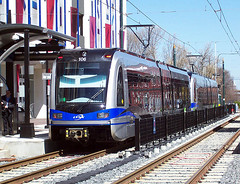Transit needs financial support now, but will states & locals deliver? A tale of two cities

Posted February 20, 2009 at 1:35PM
A number of times now, I've been drawn to Charlotte (somewhat against my North Carolina-bred instincts, given what the Queen City has been) for blog posts about the city's rejuvenation through transit-oriented development. It is a real success story, no doubt.
 Turns out that I'm hardly the only one. My colleague Jen Henry has pointed those of us who work on the subject to an excellent new video from PBS using Charlotte to illustrate the results that investment in public transit can produce. The irony, though - and the challenge - is that, with transit ridership nationally at a 50-year peak and growing, transit operators are desperately short of cash and facing service cutbacks. The stimulus can help, but only if it is spent wisely.
Turns out that I'm hardly the only one. My colleague Jen Henry has pointed those of us who work on the subject to an excellent new video from PBS using Charlotte to illustrate the results that investment in public transit can produce. The irony, though - and the challenge - is that, with transit ridership nationally at a 50-year peak and growing, transit operators are desperately short of cash and facing service cutbacks. The stimulus can help, but only if it is spent wisely.
As PBS's website states:
"President Obama's stimulus money is nearly out the door and on its way to the states, but will it be spent in the way it is intended?
"One alarming example: Mass transit. Cities and states, strapped for money, are cutting back on mass transit even as it becomes more popular with Americans. Meanwhile, President Obama is calling for increased mass transit as a necessary step toward energy independence. Will the government's investment dramatically revitalize our national travel infrastructure, or will states spend the money according to 'business as usual'?"
The structure of the stimulus, with its emphasis on "shovel-ready" construction projects (including transit construction projects) rather than operating expenses, where the greatest shortfalls are, doesn't help. But Charlotte's success certainly suggests the right answer. The video is not a short one, at 24 minutes, but it is really good:
The Charlotte story contrasts sharply with an op-ed in the Pittsburgh Post-Gazette, also about transportation dollars in the stimulus legislation.
The Pittsburgh story was written and forwarded to me by Kirk Savage, a professor of the history of art and architecture at the University of Pittsburgh. Kirk is concerned that, instead of transit investment, his region will spend the money on something called the Mon-Fayette Expressway, which Kirk calls "the road to yesteryear." It would wreak major damage on what is left of the historic community of Braddock and several others. Kirk writes:
"The perfect [stimulus] test case is right here in southwestern Pennsylvania: the $5 billion and counting Mon-Fayette Expressway. As the Mon-Fayette goes, so goes the stimulus plan and the nation.
"First, a little background. The Mon-Fayette Expressway was initially proposed more than a half century ago when steel-making was king and the population of the Pittsburgh region was reaching its peak.
Since 1960, with the collapse of the steel industry, the region's population has steadily declined, but suburban sprawl, paradoxically, has accelerated. Pittsburgh's population has plummeted by almost 50 percent, but freeways have sprouted hither and thither and car traffic into and out of the city has only gotten worse . . .
"So this is our stimulus for the new economy: an 'expressway' that will move a shrinking population in more cars for ever longer distances, all in a misguided effort to sustain the past century's binge of housing tracts and shopping malls."
Read the full article here. This is a tale of two cities, one looking forward, one apparently looking backward, and what they teach us about where our spending priorities need to be.